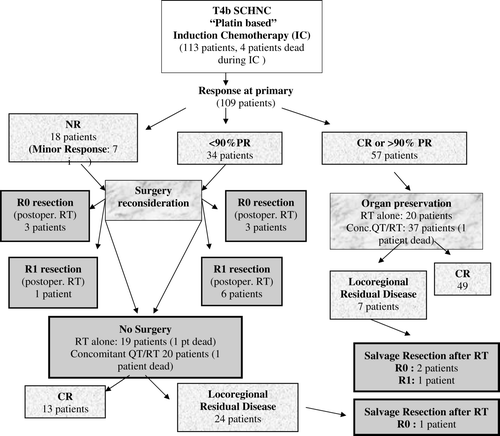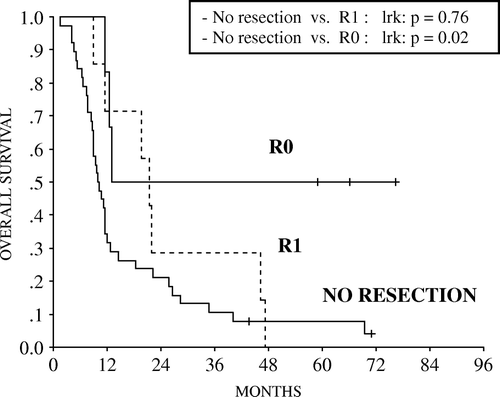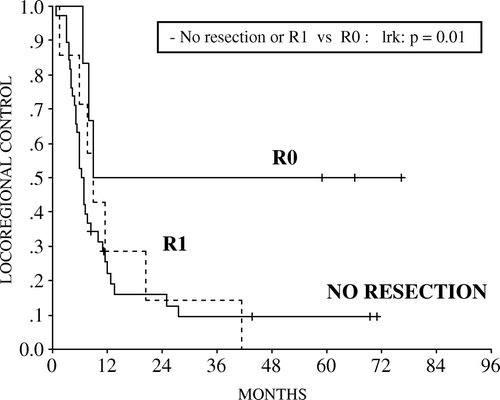Abstract
Background. Standard treatment of patients with T4b squamous cell head and neck cancer (T4b-SCHNC) is concomitant chemo-radiotherapy (CT-RT). Recent Phase III trials with Taxane containing induction chemotherapy (IC) suggest that IC could also play a role in this setting. The value of resecting the residual mass after IC and before RT is not yet clear in this context. Methods. We present the results of a retrospective analysis. Results. Between 1984 and 2001, 113 patients (patients) with T4b-SCHNC were treated at our institution with IC. Four patients dead during IC and 57 patients achieved a complete or a >90% partial response at primary and proceeded to definitive RT (or concomitant CT/RT). Surgical resection was reconsidered after IC and before RT in the other 52 patients. Surgery was performed in 13 of them: in 7 patients resection was R1, all of them had loco-regional progression (2 also developed systemic metastases) and median OS after surgery was 21 months, with no patient alive at 48 months. In the other 6 patients a R0 resection was performed: 3 of these patients had loco-regional relapses (1 also developed systemic metastases) and the other 3 patients remain alive and disease free 56, 62 and 72 months after surgery. Considering the 52 patients that achieved less than a 90% partial response at primary with IC, overall survival was equivalent when no Resection or an R1 resection was performed after IC (5 year OS 8 vs. 0%, lrk, p=0.74), but a statistically significant improvement in OS was observed when an R0 resection was obtained (5 years OS 50%, lrk, p=0.02). Conclusions: R0 resections after IC and before RT could indicate an improvement in OS in patients with T4b-SCHNC that obtain less than a 90% PR at primary after IC. We consider that this approach deserves further research in prospective clinical trials.
The incidence of squamous cell head and neck cancer (SCHNC) in the United States in 2003 was 16 cases/100 000 people and year; it represents only a 2.8% of the total new cancer cases Citation[1]. In the European Union this incidence was higher: in the 2006, the total incidence was 110 000 new cases (28 new cases/100 000 people and year) and 42 000 patients died due to this disease Citation[2].
Nearly 60% of the patients with SCHNC have locally-advanced disease at diagnosis (UICC 2002 TMN Citation[3] Stages III-IV) and in nearly half of these patients disease is not resectable (Stage IVB) either due to extensive primary disease (T4b) or because important nodal affection (N3) Citation[4].
Since the publication of various phase III trials Citation[5–8] and a meta-analysis Citation[9] suggesting the superiority of concomitant chemo-radiotherapy (CT/RT) over radiotherapy alone, and over sequential chemotherapy and radiotherapy in terms of overall survival and loco-regional control, concomitant CT/RT has been considered the standard treatment in patients with stage IVB SCHNC. Nevertheless, survival with this approach remains poor and 5-year survival rates still remains in the range of 20 to 30% Citation[10]. The interest in the role of induction chemotherapy (IC) has been highly increased in the last two years due to the positive results of different Phase III trials comparing PF with new induction regimens adding a Taxane to PF in terms of overall survival Citation[11–14]. Nevertheless, the role of IC before concomitant CT/RT is not clear and is been currently investigated by some groups Citation[15].
Local control failure is the main cause for the poor overall survival in T4B SCHNC patients treated with concomitant CT/RT or IC followed by radiotherapy (RT) or concomitant CT/RT. The role of adding surgery to the residual mass after IC (if the resection is technically feasible) is not yet clear. We present the results of a retrospective analysis focused on this topic of T4b SCHNC treated in our institution with IC.
Patients and methods
Between 1984 and 2001, 377 patients with locally advanced SCHNC have been treated with platinum based IC at our institution. All these patients were “re-staged” according the UICC 2002 TMN system and 113 of them had T4b tumors.
Induction chemotherapy (IC) regimens used were: PF: Cisplatin 100 mg/m2 i.v day 1 and 5-FU 1.000 mg/m2/day in continuous infusion days 1 to 5 every 21 days during 3 or 4 cycles; UFTVP: Cisplatin 100 mg/m2 i.v. day 1, Vinorelbine 25 mg/m2 i.v. day 1 and 8 and UFT 200 mg/m2 p.o. days 1 to 21 every 21 days during 4 cycles; CI: Carboplatin 300 mg/m2 day 1 and Ifosfamide 1.5 mg/m2 days 1 to 3 every 28 days during 3 cycles. Chemotherapy was immediately discontinued upon evidence of tumor progression or excessive toxicity. Responses to chemotherapy were assesed by clinical evaluation (including fibroendoscopy) and CT scan. WHO criteria were used to evaluate response, as was usually done at that time. Complete response (CR) was defined as the disappearance of all clinically evident of tumor needing to have a negative biopsy of the initially affected zone to be considered as a complete response. Partial response (PR) was defined as a reduction of more than 50% of the product of the two largest perpendicular diameters of all measurable disease. Partial response better than 90% (>90% PR) was defined as a reduction of more than 90% of this product or when a positive biopsy was the only evidence of tumor. No response (NR) included stable disease (SD), disease progression (DP), or death occurring while on IC.
Patients who obtained a CR or a >90 PR at primary after IC proceed to definitive radiotherapy (or concomitant CT/RT). Primary site resection was reconsidered after IC in all patients who did not achieve a CR or a >90% PR at primary tumor. Nevertheless, response needed to be good enough to allow a complete resection of disease both at primary and at the neck. Even in those patients that did not achieved any response after IC (SD or PD), the case was reevaluated in a multidisciplinary session to reconsider surgical resection. In all resected patients, postoperative RT was considered.
Definitive radiation therapy was administered 5 days per week in one fraction of 2 Gy. Dose to the primary site was >65 Gy. A minimum of 45 Gy was bilaterally delivered to the clinically-uninvolved neck and supraclavicular regions. 60 Gy were administered in involved neck disease. When primary tumor site resections were performed after chemotherapy, post-operative RT consisted of a minimum of 60 Gy to primary tumor bed regions.
Some patients were treated with RT alone and other patients received different chemotherapy regimens concomitantly with RT: either UFT 200 mg/m2 p.o. daily; Carboplatin AUC 0.5 i.v. day 1° every 3 weeks; Cisplatin 30 mg/m2 i.v. weekly plus UFT 150 mg/m2 p.o. daily or even Docetaxel 20 mg/m2 i.v. weekly.
If there was residual disease at primary after RT or concomitant CT/RT, the patient was reevaluated in a multidisciplinary session to reconsider surgical resection.
Overall survival (OS) was calculated from the time of initiation of IC until death time. Loco-regional control was calculated from the time of initiation of IC until loco-regional progression. Survival curves were generated by Kaplan-Meier method. Log-rank test was used to compare the curves of the different subgroups.
Results
Patients′ characteristics, response to IC and locoregional treatment after IC
Between 1984 and 2001, 377 patients with locally advanced SCHNC were treated at our hospital with “Platinum-based” IC and 113 of them (30%) had T4b tumours. Four patients died during IC and 57 patients achieved a CR or a >90% PR at primary. In all the other 52 patients with <90%PR or no response after IC, surgery was reconsidered at that point. In 13 of them, primary tumour was resected. The main characteristics of the 113 T4b-SCHNC patients and their IC are summarized in . Treatment is shown in . Patient characteristics, treatment and outcome of the 13 resected patients are outlined in .
Table I. Patient characteristics (T4b, any N, M0) and induction chemotherapy.
Table II. Patient characteristics, treatment and outcome of patients resected after induction chemotherapy (IC).
Relapse, overall survival and locoregional control
The four patients resected after definitive RT (or concomitant QT/RT) had a locoregional relapse and died due to progressive disease (2 of them also developed systemic disease). Median overall survival (OS) after surgery in this group was 14 months. No patient was alive at 25 months.
All the 7 patients with R1 resections after IC had loco-regional relapses (2 of them also developed systemic metastases). Median OS after surgery was 17 months having no patient alive at 44 months.
Concerning the 6 patients with R0 resection after IC, 3 of them had loco-regional relapses (1 of them also developed systemic metastases) and died due to progressive disease. The other 3 patients remain alive and disease free 56, 62 and 72 months after surgery.
Overall survival (OS) and locoregional control (LRC) of the 57 patients who achieved a CR or a >90%PR at primary were: 5 year actuarial OS: CR: 32%; >90%PR: 32%; 5 year actuarial LRC: CR: 56%; >90% PR: 33%. In these cases surgical resection after induction chemotherapy was not considered as per protocol.
Considering the 52 patients that achieved less than a 90% partial response at primary after IC, overall survival () was equivalent when no resection or an R1 resection was performed after IC (actuarial 5 year OS 8 vs. 0%, lrk, p = 0.74) but a statistically significant improvement in OS was observed when a R0 resection was obtained (actuarial 5 years OS 50%, lrk, p = 0.02). Concerning locoregional control (), again no differences were seen between no resection after induction chemotherapy and R1 resection (5 year actuarial LRC: <90% PR/No resection: 16%, No Response/No resection: 8% vs. R1 resection: 0%, lrk: p:NS) but a statistically significant improvement in LRC was observed when a R0 resection was obtained (actuarial 5 years OS: 50%, lrk, p = 0.01).
Discussion
In the meta-analysis published in 2000 Citation[9], IC only added to loco-regional treatment a small benefit in terms of OS (HR 0.90, 95% CI 0.85–0.94; absolute survival benefit of 4% at 2 and 5 years). This meta-analysis also suggests a trend to longer survival with CT/RT over sequential chemotherapy and RT (HR 0.91, 95% CI 0.79–1.06). Despite these results, many investigators think IC remains being an interesting approach. In one hand, IC before concomitant chemo-radiotherapy could further improve overall survival of concomitant chemo-radiotherapy alone and this question is currently been investigated in various ongoing Phase III trials (TTCC Citation[15], DECIDE). Moreover, the interest of IC has been importantly improving in the last two years due to the positive results of various Phase III trials that have compared PF with new induction regimens adding a Taxane to PF. The results of three phase III trials comparing Docetaxel, Cisplatin and 5-FU (TPF) with PF and one trial comparing Paclitaxel, Cisplatin and 5-FU (PPF) with PF as induction therapy in locally advanced SCHNC have been recently presented: In the EORTC-24971/TAX-323 trial Citation[11] a total number of 358 patients with non-resectable LA-SCHNC were included and a significant improvement in OS (lrk: p = 0.01; HR:0.73) was observed in the TPF arm. In the TAX-324 trial Citation[12], that included 501 patients with LA-SCHNC (35% of them were non resectable), TPF was also superior to PF in terms of OS (lrk: p = 0.005; HR:0.7). In the GORTEC-2000-01 trial Citation[13], that included 205 patients with resectable tumours of larynx or hypopharynx, TPF was superior to PF in terms of larynx preservation (lrk: p = 0.03) and nearly superior in terms of OS (lrk: p = 0.09). The combination of Paclitaxel, Cisplatin and 5-FU was compared with PF as induction therapy in a Phase III trial Citation[14] that included 382 patients (64% of them were non resectable). In this study, the arm with Paclitaxel was superior in terms of CR rate (33 vs. 14%. p < 0.001) and a trend to longer OS was also observed (lrk: p = 0.06) being this difference more clear in patients with unresectable disease (lrk: p = 0.04).
Main cause of death in these patients is locoregional control failure. The role of the addition of surgery in initially unresectable patients is not clear yet. This surgery could be performed after radiotherapy or concomitant chemo-radiotherapy (in those patients with residual disease). In our experience, these approach was only done in 4 patients (R0: 3 patients, R1: 1 pt), obtaining very poor results. All of them had locoregional progression and died in less than 25 months after surgery.
Nevertheless, if IC is used, surgery could also be considered after IC and before RT or concomitant CT/RT. Moreover, surgery performed following chemotherapy alone has less morbidity than when it is done after CT/RT. Achieving a complete or a nearly complete response after IC is a favourable predictor of locoregional control and overall survival with RT or concomitant QT/RT. Nevertheless, patients with poor response to IC have a poor outcome Citation[10]. It has not yet been described if surgery could improve results in patients with a partial or minor response to IC that could allow reconsideration of surgical resection. In our experience, it seems that a obtaining an R1 resection is not useful in these context. However, considering those patients in which it was achieved an R0 resection (only 6 patients), 50% of them could achieve long-term locoregional control and survival. Moreover, those patients with an R0 have a significantly better OS and LCR than patients in which the tumour was not resected or an R1 was achieved.
In conclusion, this study suggests that R0 resections after induction chemotherapy and before radiotherapy could improve locoregional control and overall survival in patients with T4b SCHNC who have not achieved a complete or a >90% partial response after induction chemotherapy. Nevertheless, due to the small number of patients and the retrospective nature of the analysis this study should be considered with caution and this approach should be further investigated in well conducted prospective clinical trials.
Acknowledgements
Declaration of interest: The authors report no conflicts of interest. The authors alone are responsible for the content and writing of the paper.
References
- Jemal A, Murray T, Samuels A, Ghafoor A, Ward E, Thun MJ, et al. Cancer statistics, 2003. CA Cancer J Clin 2003; 53: 5
- Ferlay J, Autier P, Boniol M, Heanue M, Colombet M, Boyle P. Estimates of the cancer incidence and mortality in Europe in 2006. Ann Oncol 2007; 18: 581–92
- American Joint Committee of Cancer. AJCC Cancer Staging Handbook. 6th ed. New York: Springer-Verlag; 2002.
- Vokes EE, Weichselbaum RR, Lippman S, Hong WK. Head and neck cancer. N Engl J Med 1993; 328: 184–94
- Paccagnella A, Orlando A, Marchiori C, Zorat PL, Cavaniglia G, Sileni VC, et al. Phase III trial of initial chemotherapy in stage III or IV head and neck cancers: A study by the Grouppo di Studio sui Tumori della Testa e del Collo. J Natl Cancer Inst 1994; 86: 265–72
- Brizel DM, Albers ME, Fisher SR, Scher RL, Richtsmeier WJ, Hars V, et al. Hyperfraccionated irradiation with or without concurrent chemotherapy for locally advanced head and neck cancer. N Engl J Med 1998; 338: 1798–804
- Merlano M, Benasso M, Corvo R, Rosso R, Vitale V, Blengio F, et al. Five-year update of a randomized trial of alternating radiotherapy and chemotherapy compared with radiotherapy alone in treatment of unresectable squamous cell carcinoma of the head and neck. J Natl Cancer Inst 1996; 88: 583–9
- Wendt TG, Grabenbauer GG, Rödel CM, Thiel HJ, Aydin H, Rohloff R, et al. Simultaneous radiochemotherapy versus radiotherapy alone in advanced head and neck cancer: A randomized multicenter study. J Clin Oncol 1998; 16: 1318–24
- Pignon JP, Bourihis J, Domenge C, Designe L. Chemotherapy added to locoregional treatment for head and neck squamous-cell carcinoma: Three meta-analysis of updated individual data. MACH-NC Collaborative Group. Meta-Analysis of Chemotherapy on Head and Neck Cancer. Lancet 2000; 355(9208)949–55
- Forastiere A, Koch W, Trotti A, Sidransky D. Head and neck cancer. N Engl J Med ;345:1890–900. Erratum in: N Engl J Med ;346 2001; 2002: 788
- Vermorken JB, Remenar E, Van Herpen C, Germa Lluch J, Stewart S, Gorlia T, et al A randomized phase III multicenter trial of neoadjuvant Docetaxel plus Cisplatin plus 5-Fluorouracil versus neoadjuvant Cisplatin plus 5-Fluorouracil in patients with locally advanced unresectable squamous cell carcinoma of the head and neck. Proc ASCO 2004. Abst 5508.
- Posner MR. Docetaxel added to induction therapy in head and neck cancer. Scientific Special Session. ASCO-2006.
- Calais G, Pointreau Y, Alfonsi M, Sire C, Tuchais C, J. Tortochaux, et al Randomized phase III trial comparing induction chemotherapy using Cisplatin (P) fluorouracil (F) with or without docetaxel (T) for organ preservation in hypopharynx and larynx cancer. Preliminary results of GORTEC 2000-01. Proc ASCO 2006. Abst 5506.
- Hitt R, López-Pousa A, Martínez-Trufero J, Escrig V, Carles J, Rizo A, et al. Phase III study comparing Cisplatin plus 5-Fluorouracil to Paclitaxel, Cisplatin and 5-Fluoruracil induction chemotherapy followed by chemoradiotherapy in locally advanced head and neck cancer. JCO 2005; 23: 8636–45
- Hitt R, Grau J, Lopez-Pousa A, Berrocal A, Sastre J, Belon J, et al Phase II/III trial of induction chemotherapy (ICT) with Cisplatin/5-Fluorouracil (PF) vs. Docetaxel (T) plus PF (TPF) followed by chemoradiotherapy (CRT) vs. CRT for unresectable locally advanced head and neck cancer (LAHNC). Proc ASCO 2005. Abst 5578.


